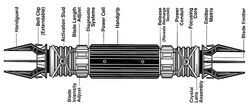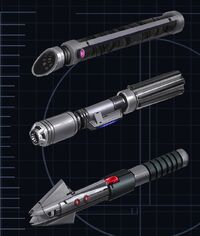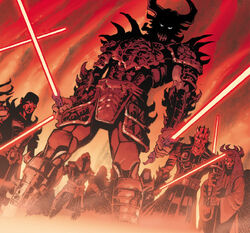| | |
- «Leave your weapons, and your former selves, here in this chamber—or depart now and forever in shame, before it is too late to turn back.»
- ―The inscription on the wall of a Sith lightsaber chamber
Sith lightsabers were lightsabers wielded by members of the Sith. For the most part, the design differences were minimal, due to the typical modern lightsaber being based on original Sith designs. Sith lightsabers almost always utilized synthetic crystals as opposed to the natural crystals favored by the Jedi, a fact they considered to be a mark of superiority. Also, most Sith weapons featured an overall more aggressive design aesthetic. One of the variations on typical Sith lightsabers was the double-bladed lightsaber. Being of Sith design, these staff-weapons were sometimes referred to as Sith lightsabers, though were not to be confused with the genuine article.
The design of these weapons changed greatly over the centuries since the founding of the Sith, sometimes featuring a standardized mold, other times being designed by individual wielders. Despite this evolution, they were almost always distinguished by their scarlet bloodshine blades, a result of the red coloration usually taken on by synth-crystals. Ultimately, the Sith wielded these weapons to mock the Jedi, a trait demonstrated by the exceptional combat effectiveness the aggressive Sith Lords possessed.
Specifications[]
Mechanics and Distinguishing Features[]

A sketch of a Sith lightsaber presented in The Jedi Path: A Manual for Students of the Force.
The early Sith lightsabers were simply an improvement on the preexisting Protosabers favored by the Jedi Order. The protosabers, while leaps and bounds ahead of the original lightsaber prototypes with their unstable blades, suffered from severe issues regarding energy consumption, necessitating a belt-mounted power pack. The Sith design introduced an internal superconductor, which transferred the returning looped energy from the negative-charged flux aperture back into an internal power cell. With this modification, the power cell would only expend power when the energy loop was broken, such as when the lightsaber cut something, solving the power supply problem.[1][3][4]
The ancient Sith Lords took this miniaturization a step further with the creation of the double-bladed lightsaber. These original saberstaffs featured sophisticated designs, effectively a single mechanism with twin emitters on either end of a standard length hilt. Later designs would be considerably simplified, with the result being a double-length hilt consisting of two separate lightsaber mechanisms.[1][5] Of lesser note was the design of the Lightfoil by the Sith-aligned Mecrosa Order, which also miniaturized the standard lightsaber design to create extremely well balanced one-handed weapons.[6]
However, the defining feature of Sith lightsabers was the use of synthetic crystals, as opposed to the Adegan and Ilum crystals favored by the Jedi. Almost all synthetic crystals used by the Sith featured a red coloration, as a result of the forging process used to create them, though adjustments to this process and manipulations through the Force did result in crystals of different colors.[6] Synth-crystals typically produced stronger blades than the natural Jedi crystals, and had the rare potential to "break" the blades of standard lightsabers by overloading the energy matrix and instantly burning out the opponent's weapon.[7] However, this added strength came at the cost of blade instability, and loss of maneuverability.[8]
Cultural and symbolic significance[]
- "The Sith grew past the use of lightsabers. But we continue to use them, if only to humiliate the Jedi."
- ―Darth Sidious
Originally, Sith Lords utilized synthetic crystals due to their lack of access to the traditional sites where crystals were harvested, as these were frequented by the Jedi Order. Eventually, the use of these synth-crystals became a tradition among the Sith, who believed the creation of a crystal suited to one's own needs was a display of strength over the Jedi, who relied on the "untamed wilds of space" to provide.[6]

Palpatine's blue-bladed lightsaber, was originally a Jedi weapon, he used after his resurrection.
The red coloration was also a result of the forging process, though it too came to become a tradition. The aggressive crimson hue served to differentiate the Sith from their sworn enemies; the Jedi, who typically utilized softer colors, commonly blue or green.[1] However, the bloodshine blades were not universal to all Sith, with notables such as Exar Kun and Darth Vader continuing to favor their blue Jedi lightsabers after defecting. However, Kun was likely unaware of the custom, and Vader replaced his Jedi weapon with a red-bladed Sith saber soon afterwards. After his reincarnation, Darth Sidious aka Palpatine used a blue-bladed lightsaber when he fought Luke onboard his Super Star Destroyer Eclipse.Ultimately, Sith who wielded colors other than red were usually looking to disguise their dark affiliations. In fact, Palpatine was of the opinion that the Sith Lords had outgrown the use of lightsabers, and only continued to use them to humiliate the Jedi.[9]
Certain Sith organizations appeared to view lightsabers as status symbols, indicating the completion of their training. During training, Sith apprentices typically utilized Sith training sabers, or were provided with Vibroblades when expected to engage in actual combat.[10][11][12]
History[]
Origins[]
- "Although lightsabers are a superior weapon, there is still nothing quite as satisfying as feeling the warm spray of blood when one cleaves through one's enemy with a real sword."
- ―Komok-Da
When the Dark Jedi dissidents rebelled against the greater Jedi Order and started the Hundred-Year Darkness, they retained the use of their Jedi Protosabers, wielding them against their former brethren. At the conclusion of the conflict, the Darksiders were disarmed and exiled from Republic space, founding a new society based around their corrupted Jedi philosophy and the necrotic Force magicks of the conquered Sith peoples. During this early era, notables such as Karness Muur continued to display their protosabers, indicating that some had managed to hold on to their weapons.[13][14]
A militant culture, Sith weaponry developed quickly. The original protosaber design was upgraded, allowing for the removal of the belt-mounted power pack and resulting in the modern lightsaber. The usage of red synth-crystals appears to have been standard amongst the Sith in this time period, at least amongst those who favored lightsabers.[15] For the most part, many Sith Lords eschewed lightsabers in favor of Sith swords. When the Sith Empire engaged the Galactic Republic in the Great Hyperspace War, the swords were extremely prevalent, but certain groups, such as the crew of the Omen, were equipped with lightsabers.[4] These early Sith lightsabers no doubt made their way into Jedi hands, who then copied the designs to upgrade their own weapons.
Use during the Great Sith War[]
- "Time to make this more interesting. Do you like the modifications I made to my lightsaber, Master?"
- ―Exar Kun reveals the second blade of his lightsaber
A reasonably notable development was the creation of the Lightfoils by the Sith-aligned Mecrosa Order. Lightfoils were a masterwork of design and craftsmanship; a perfectly balanced one-handed lightsaber that provided far greater precision. These weapons were designed for use by adherents of the Makashi lightsaber style, as the form's focus on precision and balance put the attributes of the lightfoil to good use. However, while the archaic lightfoil design was a sophisticated masterpiece, later imitations fashioned by nobles of the Tapani sector proved to be far less effective. These knockoff lightfoils were used by "Saber rake" duelists in honor duels between nobles.[6]

A schematic of Exar Kun's Sith lightsaber.
When Exar Kun fell to the dark side of the Force and became the new Dark Lord of the Sith, he and his followers continued to wield their original Jedi lightsabers, likely due to their ignorance regarding the customary Sith bloodshine blades. However, this likely facilitated their infiltration of the Jedi Order, allow Kun to enter the Ossus Great Jedi Library and steal a Sith holocron, and his followers to get close to their former masters and carry out the Sith uprising.[17]
However, while Kun failed to institute the widespread use of synth-crystals, he did modify his own lightsaber considerably, basing the changes on Sith designs accessed in a holocron. The result was his double-bladed lightsaber. Being based off of classical Sith schematics, Kun's saberstaff retained the standard hilt length, allowing him to pass it off as a regular lightsaber, before revealing the extra blade in the heat of combat and catching his opponent off-guard.[1][16] Kun's weapon was infused with the negative energies of its creator,[18] and those who faced him were unsettled by its insidious nature.[19] Inheritors of the weapon who were sensitive to the Force found themselves infected with the lightsaber's residual malevolent power, while those with no such affinity remained unaffected.[18]
After the war, one of Kun's former acolytes, the disfigured Haazen, would be taken in by Krynda Draay. His involvement in the war largely unknown, he became one of the founding members of Draay's Jedi Covenant, gradually taking complete control of the organization as Krynda's primary lieutenant. During this period, Haazen constructed a Sith lightsaber to replace the weapon he lost during his failed Jedi apprenticeship. However, due to his need to keep the weapon and his continuing affiliation to Sith ideals secret, he fashioned an articulated hilt that folded into a hook-shape to become the handle of his cane. The make of the hilt overall followed the grisly design of his prosthetics, themselves of an archaic Sith design, and he utilized the traditional bloodshine blade. This lightsaber would be kept secret for decades before finally being unveiled during the Vindication incident, the culmination of all of Haazen's schemes. Haazen would wield the weapon against several Jedi before bestowing it on Lucien Draay, his would-be Sith apprentice. Draay initially operated as Haazen's willing dupe, attacking Zayne Carrick with the lightsaber before reconsidering his position and betraying Haazen. Draay disgarded the lightsaber, and it was destroyed by orbital bombardment during the destruction of the Draay Estate, along with Haazen himself.[20]
During the Jedi Civil War started by Darth Revan, synthetic crystals and double-bladed lightsabers saw widespread usage. However, beyond the red blades, there was little to differentiate the design of these Sith lightsabers from the Jedi weapons of the period. During training, many Sith apprentices wielded Vibroblades when expected to engage in actual combat, until they earned their lightsabers. Students of the Korriban academy would perform a final test at the conclusion of their training, with one of the rewards being a unique, proper Sith lightsaber for them to keep.[10] During the First Jedi Purge that followed, little changed in the design of Sith lightsabers, though some groups, such as the Sith assassins, eschewed lightsabers in favor of more covert weapons, such as Force pikes.[21]
Usage and Development during the Great Galactic War[]
- "A Sith Warrior's skills with a lightsaber are unrivaled. Driving at their enemies with strong, crushing blows, the Warrior quickly beats his foes into submission or death. Though the lightsaber is the Warrior's primary method of attack, he also uses his dark command of the Force to paralyze, terrify, and kill."
- ―The combat tactics of a Sith Warrior

Three Great Galactic War-era Sith lightsabers.
During the reformation of the Sith Empire, the classical Sith swords were generally swept by the wayside in favor of lightsabers. Overall, the standard Sith lightsabers of the era featured aggressive, squared-off technical designs, in contrast to the more rounded weapons favored by the Jedi. In addition to the traditional scarlet lightsaber crystals, Sith lightsabers would often have elaborate emitter guard assemblies, with a double axe-head design being prevalent. This style of armament was exemplified by the Sith Warrior class, who favored standard lightsabers but emphasized power and aggression in their use.[23]
The more esoteric models were favored by the Sith Inquisitor class, who often wielded saberstaffs. Inquisitor lightsabers, while still demonstrating the aggressive and angular design characteristic of Sith weapons, also featured strange design elements, such as exposed or oversized crystal chambers, or translucent hilts with electrical energy flowing through it.[23] Also, Inquisitors would occasionally eschew the traditional scarlet crystals in favor of violet blades.[24]
Despite the widespread standardization, many Sith Lords would favor more unique weapon designs. Darth Baras' lightsaber hilt was composed of a large fang or claw that lent it a slight curve, and the emitter featured a triple-guard.[25] Darth Chratis, in contrast, wielded a long staff that collapsed to form a long-handled lightsaber.[26] The Sith apprentice, Teneb Kel, wielded a double-bladed lightsaber of the classical Sith design, with a standard length hilt. However, he typically displayed his two-ended weapon immediately, rather than capitalizing on the smaller hilt to fool enemies into believing it a standard lightsaber.[27]
Usage during the New Sith Wars[]
- "At my request, the armorer analyzed the Sith lightsaber that I'd recovered from Wud Mortall. She confirmed that his lightsaber contained synthetic crystals, as did every other Sith lightsaber she ever examined."
- ―Pernicar
Little is known of the development of Sith lightsabers during the New Sith Wars, as the conflict itself tended to wax and wane with the passage of years, and many records were lost. Many of the Sith, such as Darth Ruin, appeared to favor standard lightsabers with crimson blades, though some diverged and wielded alternative weaponry.[1]
When Lord Kaan came to power, Sith lightsaber designs were considerably standardized. Apprentices training at the Sith academies trained with Sith training sabers, and were provided with stock lightsabers upon their graduation. Apprentices appeared to have the option between standard and double-bladed lightsabers, and were armed accordingly. Jedi Master Pernicar was given the opportunity to examine one of these lightsabers, after taking it from his fallen student Wud Mortull. He noted the inferior quality of these lightsabers compared to Jedi weapons, and considered them an insult to their heritage.[12][1]
Notably, the then-Sith Blademaster Kas'im gifted the lightsaber of his master to his prize pupil, Bane. The lightsaber was of a unique curved design, allowing the hilt to fit better into the hand. This facilitated both greater blade control and power, which complemented Bane's chosen fighting form. Bane would replace the ruby gem it contained with a traditional synth-crystal provided by the Academy staff. Kas'im himself normally wielded a double-bladed lightsaber, but when pressed, he would separate the hilt of his weapon into two halves, wielding dual blades. To take further advantage of this feature, Kas'im actively discouraged the use of dual-blade combat, defending his decision by citing the deficiencies of such a method.[12]
Usage under the Rule of Two[]
- "Let it be nothing more than what it is; an instrument of murder, and nameless."
- ―Darth Maul on his lightsaber
The institution of the Rule of Two drastically limited the number of advanced Sith practitioners, effectively reducing them to a cult rather than a cohesive organization. As such, Sith lightsaber designs were based more on personal needs and preferences, rather than standardized makes designed for specific classes. For example, Darth Bane's apprentice Zannah wielded a double-bladed lightsaber with a lengthened hilt and shortened blades to allow for improved speed and mobility, benefits she took advantage of to facilitate her practice of the Soresu lightsaber form. In combat, she would twirl the weapon to build up momentum, allowing her to redirect and parry even the fiercest attacks with relative ease, while the second blade allowed for rapid counters.[29] One of the later Rule of Two Sith Lords, Darth Maul, also favored the double-bladed lightsaber. Maul felt that single-bladed lightsabers were too limiting, and opted for the double ended design because it made sense to him to be able to strike with both ends.[30] Maul took considerable pride in the fashioning of the crystals for his weapon. Creating a set of four synthetic lightsaber crystals in a compression furnace, he went into deep meditation for four days, using the Force to control and monitor the formation of the crystals.[31]

Darth Sidious' lightsaber, an atypical Sith lightsaber design.
One of the most unique lightsabers carried by a Dark Lord of the Rule of Two was the weapon of Darth Sidious. Constructed during his apprenticeship under Darth Plagueis,[1] Palpatine's lightsaber was of an elegant and streamlined designed, with a hilt composed of phrik alloy, precious aurodium, and gleaming electrum.[32] During his tenure as Supreme Chancellor of the Galactic Republic, Palpatine's lightsaber was concealed in a neuranium statue in his offices, where it would rest for decades before finally seeing use. Palpatine retrieved the lightsaber just prior to a confrontation with the Jedi, killing three of his attackers with the weapon and dueling Mace Windu to a standstill. Windu managed to disarm and corner the Sith Lord, though he was killed by another almost immediately afterwards, and Palpatine already had an identical backup weapon prepared, which he wielded against Jedi Grand Master Yoda.[33]
It was not uncommon for Jedi defectors to continue wielding their original Jedi lightsabers, and this was true for Palpatine's second apprentice, Dooku. Dooku was a master of the precise Makashi style, and wielded a custom lightsaber designed to facilitate his chosen fighting form. His refined weapon, featuring an elegant curved hilt, was taken with him when he left the Jedi Order and turned to the Sith. As a Sith lightsaber, the weapon had its original blue Adegan crystal replaced with a scarlet Sith synth-crystal, which improved the weapon's cutting power at the expense of maneuverability.[34] The lightsaber would see extensive use against Jedi in numerous lightsaber duels, but would ultimately be used against its owner by his ultimate successor.[35]

Asajj Ventress and Savage Opress, Sith Acolytes, both wield Sith-style lightsabers.
During the Clone Wars, Dooku would found the Dark Acolytes, a personal cadre of fallen Jedi-turned-Sith Acolytes. Many of the Acolytes would display a reverence for Sith ideals, and would display many trappings of the Order.[36] Most notably, all would wield Sith-style lightsabers; though most were simply their original lightsabers with their Ilum crystals replaced with synth-crystals. Quinlan Vos was notably provided with the scarlet crystal originally used by Darth Andeddu.[37] Asajj Ventress was notably provided with the twin curved lightsabers of Komari Vosa.[38] Vosa was a failed Jedi who was captured and recruited into the Bando Gora cult, and constructed the lightsabers during her membership.[39] The lightsabers were based off of the design of Dooku's lightsaber, as he was Vosa's former master. While the lightsabers were not created as such, they did form a reasonable approximation of Sith lightsabers.[40] Another of the Acolytes, Savage Opress, took a different route, constructing his own lightsaber upon his recruitment. This weapon was a double-bladed lightsaber of a more classic Sith design, with a long hilt, a ridged grip on the middle portion, and aggressive blade-guards on either emitter.[41]
Usage under the Galactic Empire[]
- "The weapons of the Jedi were destroyed along with the Jedi. There are rumors that some lightsabers remain in the private collections of the extremely wealthy. But the only one that I am certain truly exists belongs to Darth Vader, and I doubt he'd part with it willingly."
- ―Haninum Tyk Rhinann

Galen Marek performs telekinetic maintenance on his Sith lightsaber.
One of the first Sith lightsabers to be created during the reign of the Sith-controlled Galactic Empire was Darth Vader's weapon. A former Jedi, Vader attempted to create a novel design to both impress Palpatine and distance himself from his former comrades. However, despite having Palpatine's lightsaber provided as a model, Vader's resulting weapon was little more than an enlarged version of his first Jedi lightsaber, machined out of black alloy.[9] While the initial crystal Vader utilized was a synth-crystal provided by Palpatine, Vader would later use a red-hued Adegan crystal.[43] Vader's apprentice, Galen Marek, would also wield a unique lightsaber. Marek's design appeared to be based on the design utilized by Darth Vader, featuring an emitter shroud and a mostly solid casing. However, rather than follow the over-sized, bulky design of his master's weapon,[9] Marek opted for a considerably more skeletal make. His weapon featured an exposed crystal chamber, and rather than include a handgrip, the whole of the weapon was sheathed in somewhat tarnished looking bare-metal.[44] The blade utilized a set of red crystals supplied by Vader.[45]
While Palpatine continued to adhere to the Rule of Two, he did establish a number of organizations composed of Sith Acolytes who served at the whim of he and Vader. Many of these groups favored the use of lightsabers, and often wielded red blades as a sign of their reverence for Sith ideals. Most of Palpatine's servants and disciples, such as his Hands or his Dark Side Elite, favored the simple standard lightsabers. Notably, Palpatine did not enforce the use of bloodshine blades amongst the Elites, and while most did later take to wielding such blades after a time, many favored blue lightsabers.[46][47] However, other affiliates, such as the Emperor's Shadow Guard or certain members of the Royal Guard, favored more specialized weapons, such as Lightsaber pikes, and all favored the Sith bloodshine blades.[44] One of his Hands, Lumiya, defied convention and wielded a lightwhip. Her whip was heavily inspired by Sith designs, with a hilt composed of nigh-indestructible Mandalorian iron, and producing numerous tendrils of energy, further backed up by the inclusion of several additional whip tails composed of studded leather and flexible metal.[1][48]

The mass produced stock lightsabers provided to the Imperial Saber Guard and the Galen Marek clones.
Imperial engineers also found a way to mass produce lightsabers, though these weapons still had to be assembled by hand. These lightsabers were created on Kamino for the Imperial saber guard and the Galen Marek clones, and called for the mass importing of special crystals for them. The crystals in question were likely synthetics, due to the red coloration common to most, though the weapons supplied to most of the clones featured silver blades. Modified versions of the mass produced lightsabers utilized by the Marek clones would be provided to two of the more successful clones; Starkiller and the Dark Apprentice.[49] Similar mass produced lightsabers were provided to the Sa Cuis clones.[50]
Post-Imperial Sith Lightsabers[]

Members of the One Sith order wielding Sith lightsabers.
Most of the Sith Acolytes and apprentices active following the fall of the Galactic Empire favored standard lightsabers, though there were exceptions to this. Lumiya continued to wield her unique lightwhip, and her student, former Imperial Sovereign Protector Carnor Jax, wielded the double-bladed sword favored by his former comrades.[48][51][52] During his training as a Sith Lord, Darth Caedus originally continued to use his Jedi lightsaber, though only until he completed construction of his new red-bladed Sith lightsaber.[53] The Lost Tribe of Sith, the surviving descendents of the shipwrecked Omen crew on Kesh, continued to make use of the archaic Sith lightsabers their ship had been stocked with.[54]
During this period, assembly-line Sith lightsaber knockoffs continued to be produced by Remnant factions such as the Empire Reborn for various mass Dark Jedi training programs like the Reborn and the Shadowtroopers. The particular lightsabers used by those two organizations were identical, black-hilted, red-bladed designs based on the Sith lightsaber.
Sith lightsaber designs would be adopted by the Imperial Knights. Using knowledge gleaned from a surviving copy of Palpatine's Book of Anger, the Knights would utilize synthetic crystals of their own manufacture, but of a white coloration and devoid of the ceremony and meditation that the Sith Lords favored.[55] The One Sith would continue to use synth-crystals as well, but would also introduce hilts fabricated from a material that resembled Yuuzhan Vong Yorik coral. Double-bladed lightsabers saw common use among these Sith, while notables such as Darth Nihl wielded more obscure lightsaber variants. Nihl himself favored a long-handled lightsaber, also composed of the coral-like material. The reigning Dark Lord of the Sith, Darth Krayt, originally wielded twin Sith lightsabers of the then standard design. However, after his death and subsequent resurrection, he took up his old Jedi lightsaber to replace one of the pair, converting it into a Sith lightsaber with the addition of a synth-crystal.[56]
Behind the scenes[]

Concept art of Darth Vader's lightsaber.
Technically, the first Sith lightsaber designed was Darth Vader's. However, there were no early plans to make Vader's weapon distinct from the other lightsabers depicted, beyond the black styling on the hilt itself. The concept art of Vader's lightsaber hilt was based off of George Lucas's descriptions of the weapons as jewel-studded cylinders. Ultimately, the hilt carried by David Prowse was machined from the flash attachment of a British 3-cell MPP Microflash, which was used on forties-era press cameras. The ridged grip was made by gluing portions of windshield-wiper blades onto the bare cylinder, and the switch plate had been fashioned from the LED display of a 1974 calculator. The original lightsaber effect was provided by the reflective, spinning dowel that made up the blade, which appeared to glow to the camera. However, Lucas was unsatisfied with these early effects, and had the glows further augmented by rotoscoped animation. During this phase, it was decided to make the lightsabers have different color blades to further differentiate them, and Vader was given a red blade. While the methods used to create the lightsabers would change over the course of the next two movies, the presentation of Vader's lightsaber itself would remain consistent.[57]
The red coloration unique to Darth Vader's lightsaber throughout the original trilogy would give rise to the idea that the blade color of lightsabers was dictated by the moral alignment of the wielders, rather than internal mechanics, a viewpoint supported by the Marvel adaptation of Return of the Jedi, which depicted Luke Skywalker's lightsaber emitting a red blade when Vader ignited it.[58] It would not be until the release of Shadows of the Empire that lightsaber colors would be established as being determined by the internal crystals. However, not all Sith presented in subsequent years would wield red blades. The Star Wars: Tales of the Jedi story arcs Dark Lords of the Sith and The Sith War, both depicted Sith Lord Exar Kun and his followers continuing to wield their original Jedi lightsabers, while the arcs The Golden Age of the Sith and The Fall of the Sith Empire depicted the Sith Lords extensively favoring Sith swords rather than lightsabers, suggesting that they didn't have access to them. The Vector story arc of the Knights of the Old Republic comic and the Lost Tribe of the Sith E-books both retconned this, and took it a step further by suggesting that the Sith in fact pioneered the modern lightsaber design.
The double-bladed lightsaber made its first appearance in The Sith War story arc, wielded by Exar Kun. The design was conceived by artist Chris Gossett, who invisioned lightsabers as the oft-customized honor weapons of the Jedi.[59][60] The double-bladed lightsaber would make its first mainstream appearance in the hands of Darth Maul in Star Wars: Episode I The Phantom Menace. On the StarWars.com databank would be an article devoted to the weapon, which referred to it as a "Sith lightsaber", the first usage of the term. Originally, this name applied exclusively to double-bladed lightsabers, but eventually came to encompass all lightsabers of Sith design.
Appearances[]
Non-canon appearances[]
 "Prey" — Star Wars Tales 11
"Prey" — Star Wars Tales 11 Star Wars Galactic Spy on StarWars.com (article) (content now obsolete; backup link)
Star Wars Galactic Spy on StarWars.com (article) (content now obsolete; backup link)
Sources[]
Notes and references[]
External links[]
 Sith-Saber on the SWG Wiki
Sith-Saber on the SWG Wiki
